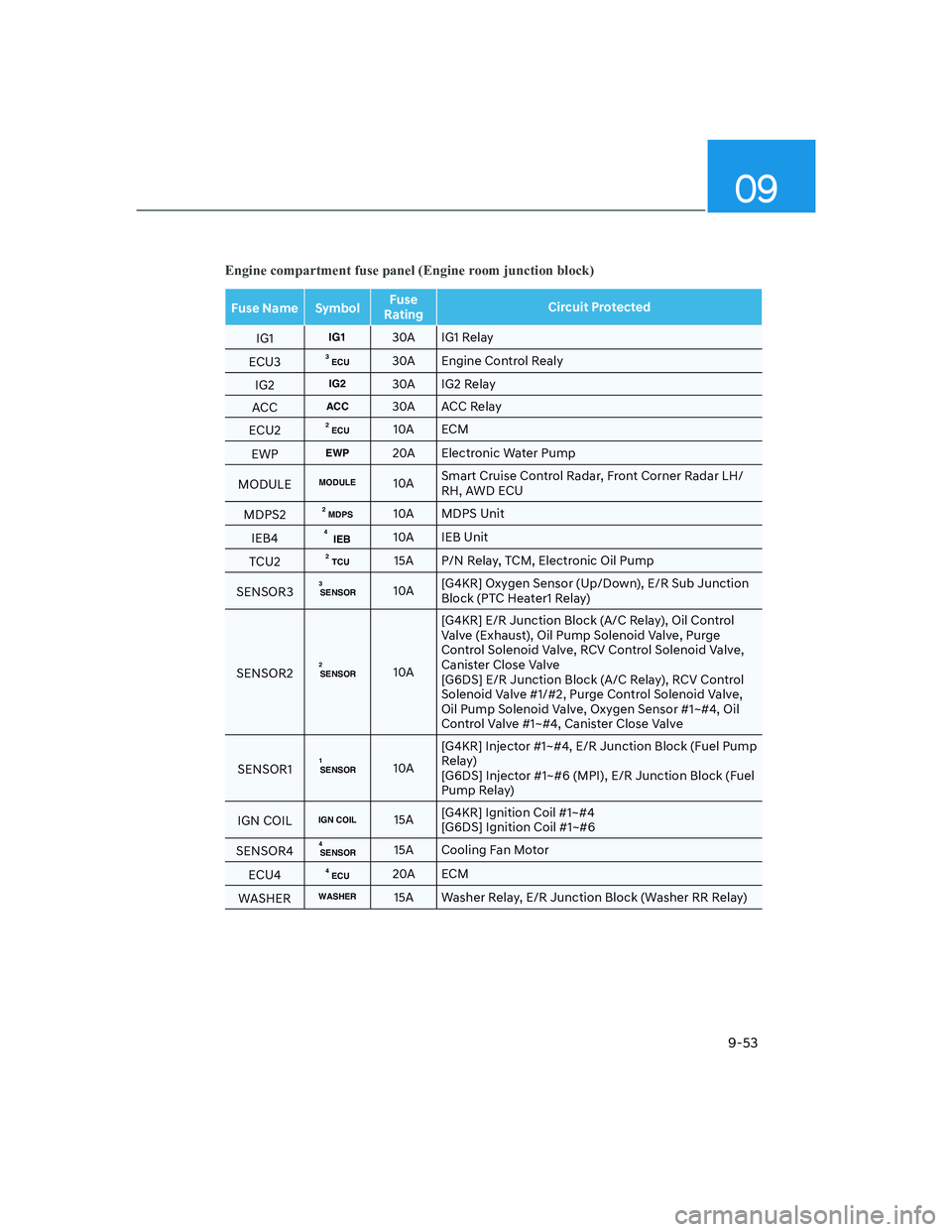Page 294 of 647

Driving Your Vehicle
6-20
Power-Assist Brakes
Your vehicle has power-assisted brakes
that adjust automatically through normal
usage.
If the engine is not running or is turned
off while driving, the power assist for
the brakes will not work. You can still
stop your vehicle by applying greater
force to the brake pedal than typical.
The stopping distance, however, will be
longer than with power brakes.
When the engine is not running, the
reserve brake power is partially depleted
each time the brake pedal is applied.
Do not pump the brake pedal when the
power assist has been interrupted.
WARNING
Take the following precautions:
• Do not drive with your foot resting
on the brake pedal. This will create
abnormal high brake temperatures,
excessive brake lining and pad wear,
and increased stopping distances.
• When descending down a long or
steep hill, use the paddle shifter
and manually downshift to a
lower gear in order to control your
speed without using the brake
pedal excessively. Applying the
brakes continuously will cause
the brakes to overheat and could
result in a temporary loss of braking
performance.
• Wet brakes may impair the vehicle's
ability to safely slow down; the
vehicle may also pull to one side
when the brakes are applied.
Applying the brakes lightly will
indicate whether they have been
affected in this way. Always test your
brakes in this fashion after driving
through deep water. To dry the
brakes, lightly tap the brake pedal to
heat up the brakes while maintaining
a safe forward speed until brake
performance returns to normal.
Avoid driving at high speeds until the
brakes function correctly.
Disc Brakes Wear Indicator
When your brake pads are worn and new
pads are required, you will hear a high
pitched warning sound from your front
or rear brakes. You may hear this sound
come and go or it may occur whenever
you depress the brake pedal.
Note that some driving conditions or
climates may cause a brake squeal
when you first apply (or lightly apply)
the brakes. This is normal and does not
indicate a problem with your brakes.
NOTICE
To avoid costly brake repairs, do not
continue to drive with worn brake pads.
Information
Always replace brake pads as complete
front or rear axle sets.
BRAKING SYSTEM
Page 336 of 647

Driving Your Vehicle
6-62
Winter Precautions
Use high quality ethylene glycol coolant
Your vehicle is delivered with high
quality ethylene glycol coolant in the
cooling system. It is the only type of
coolant that should be used because it
helps prevent corrosion in the cooling
system, lubricates the water pump and
prevents freezing. Be sure to replace or
replenish your coolant in accordance
with the maintenance schedule in
chapter 9. Before winter, have your
coolant tested to assure that its freezing
point is sufficient for the temperatures
anticipated during the winter.
Check battery and cables
Winter temperatures affect battery
performance. Inspect the battery and
cables, as specified in chapter 9. The
battery charging level can be checked by
an authorized retailer of Genesis Branded
products or in a service station.
Change to “winter weight” oil if
necessary
In some regions during winter, it is
recommended to use the “winter
weight” oil with lower viscosity In
addition, replace the engine oil and filter
if it is close to the next maintenance
interval. Fresh engine oil ensures
optimum engine operation during the
winter months. For further information,
refer to chapter 2. When you are not sure
about a type of winter weight oil, consult
an authorized retailer of Genesis Branded
products.Check spark plugs and ignition system
Inspect the spark plugs, as specified in
chapter 9. If necessary, replace them.
Also check all ignition wirings and
components for any cracks, wear-out,
and damage.
To prevent locks from freezing
To prevent the locks from being frozen,
spray approved de-icing fluid or glycerin
into key holes. When a lock opening is
already covered with ice, spray approved
de-icing fluid over the ice to remove it.
When an internal part of a lock freezes,
try to thaw it with a heated key. Carefully
use the heated key to avoid an injury.
Use approved window washer anti-
freeze solution in system
To prevent the window washer from
being frozen, add authorized window
washer anti-freeze solution, as specified
on the window washer container.
Window washer anti-freeze solution is
available from an authorized retailer of
Genesis Branded products, and most
vehicle accessory outlets. Do not use
engine coolant or other types of anti-
freeze solution, to prevent any damage
to the vehicle paint.
Page 610 of 647

09
9-53
Engine compartment fuse panel (Engine room junction block)
Fuse Name SymbolFuse
RatingCircuit Protected
IG1IG130A IG1 Relay
ECU3
ECU330A Engine Control Realy
IG2
IG230A IG2 Relay
ACC
ACC30A ACC Relay
ECU2
ECU210A ECM
EWP
EWP20A Electronic Water Pump
MODULE
MODULE10ASmart Cruise Control Radar, Front Corner Radar LH/
RH, AWD ECU
MDPS2
MDPS210A MDPS Unit
IEB4
IEB410A IEB Unit
TCU2
TCU215A P/N Relay, TCM, Electronic Oil Pump
SENSOR3
SENSOR310A[G4KR] Oxygen Sensor (Up/Down), E/R Sub Junction
Block (PTC Heater1 Relay)
SENSOR2
SENSOR210A[G4KR] E/R Junction Block (A/C Relay), Oil Control
Valve (Exhaust), Oil Pump Solenoid Valve, Purge
Control Solenoid Valve, RCV Control Solenoid Valve,
Canister Close Valve
[G6DS] E/R Junction Block (A/C Relay), RCV Control
Solenoid Valve #1/#2, Purge Control Solenoid Valve,
Oil Pump Solenoid Valve, Oxygen Sensor #1~#4, Oil
Control Valve #1~#4, Canister Close Valve
SENSOR1
1SENSOR10A[G4KR] Injector #1~#4, E/R Junction Block (Fuel Pump
Relay)
[G6DS] Injector #1~#6 (MPI), E/R Junction Block (Fuel
Pump Relay)
IGN COIL
IGN COIL15A[G4KR] Ignition Coil #1~#4
[G6DS] Ignition Coil #1~#6
SENSOR4
SENSOR415A Cooling Fan Motor
ECU4
ECU420A ECM
WASHER
WASHER15A Washer Relay, E/R Junction Block (Washer RR Relay)